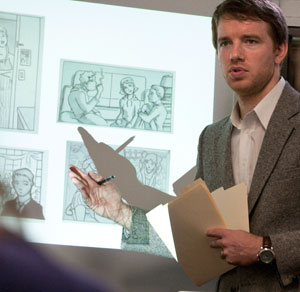Panel discussions
Artistic experience is not required for a graphic-novel class that draws storytellers.
By Ruth E. Kott, AM’07
Photography by Lloyd DeGrane

Hornschemeier leads a critique of student work, a regular class exercise that helps students learn to translate the foreign language of comic symbolism into storytelling.
None of the seven students, mostly undergraduates, in Paul Hornschemeier’s graphic-novel class is an art major. Fourth-year Madeline Underwood studies biochemistry, and Piali Yang, ’13, concentrates in computer science with a math minor. Some have more experience creating comics than others—one student wrote a final paper last year in graphic-novel form. But when admitting students to the class, Hornschemeier, a visiting lecturer, looked for good storytellers more than for experienced artists.
“I think a lot of people, when they come into the class, are worried about their drawing skill,” says Hornschemeier, the author of two full-length graphic novels, with a third, Life with Mr. Dangerous (Random House), coming out in May. “There’re always at least one or two students that I have to talk down from a ledge. Writing and storytelling, that’s what’s really important. Pretty pictures is an illustration, and I’m not teaching illustration here. I’m teaching comics.”
In his second year at Chicago teaching Writing the Graphic Novel, Hornschemeier examines different ways to tell a story in pictures, focusing on drawing the moments that make up the narrative. The students complete weekly sketchbook work, where they doodle and create graphic diaries, as well as assignments where they break up a story into single scenes, or panels. The final project is a four-page comic, using either material from their sketchbooks and previous assignments or creating an entirely new story. Basically, says Hornschemeier, he teaches the students to “synthesize autobiography and external reality” and then “infuse all that” into their stories.
Writing a graphic novel can be highly personal, but it also requires a set of commonly understood symbols that represent abstract motifs. In Maus, cartoonist Art Speigelman’s biography of his Holocaust-survivor father, for example, the author draws cats and mice to represent the Nazis and the Jews, respectively. (For more on Spiegelman and the study of graphic narratives, see “Drawn to Comics.”) “If you don’t know how to use the symbols well,” says Hornschemeier, “you’re not going to have a well-executed story.” Some students, he says, begin the class knowing how to read the symbols, but they can’t create them—somewhat akin to understanding French but not being able to articulate one’s own thoughts in the language.
So the teacher spends part of the fall-quarter class, which this year met Wednesdays for almost three hours, helping students figure out visual elements that translate their stories for an audience. Student critiques form the bulk of this training. For each project, “everybody other than the artist is allowed to say what they think is going on in the story, what they think the mechanics are, what they think is working well.” Most important, Hornschemeier says, “is realizing how your attempt to convey information has gotten across to these other people.”

Weekly sketchbook assignments keep studentsí stories on the drawing board.
During a third-week critique, Hornschemeier projected each student’s assignment—a composition made of four unrelated panels—on a white wall in the small Gates-Blake classroom, inviting the artist’s classmates to explain what was going on.
One panel, drawn by Kyle Mangan—the only graduate student in the class, Mangan is in the Master of Arts Program in the Humanities—looked like a pig with a human body, lying down and clutching his knee, surrounded by cheerleaders (or nurses) and football players. “The pig hurt his knee,” said second-year Yang.
“Maybe he’s the football?” suggested Ben Samuels-Kalow, ’12. “It’s anthropomorphizing the football.”
It also could be a mask—a mascot, maybe, Hornschemeier said. And is he naked?
The image was a streaker in a pig mask, Mangan explained at the end of the critique. “You need a little more detail to tell that he’s naked,” Hornschemeier said. “A few hairs sticking off the leg, for example.” Or a little bit of tush: “Ass crack solves all your problems.”
A panel by second-year Eric Cochrane, of a small, cartoonish-looking hippo riding a larger, realistic-looking hippo, sparked a conversation about what makes an image abstract versus realistic: “It’s all lines on paper,” Hornschemeier said. The more an artist defines his lines and adds detail and shading, the more accurate the drawing. “The second you see the eye structure,” he said, “it reads as incredibly abstracted or not at all.”
To create their drawings, students can use any materials they like—the syllabus lists pencils (mechanical, wooden, Verithin nonphoto blue), pens (Staedtler Pigment Liners, Sakura Micron, Pilot Precise V5), brushes, markers, and ink. The only thing Hornschemeier forbids: computers, except to color their final projects. He wants his students to learn the entire process of putting together a graphic novel by hand. “I want to demystify everything as much as possible,” he says. The students “need to realize that having a pen and a scrap of paper is just as valid a means of expression as a $2,000 computer.”
Return to top
